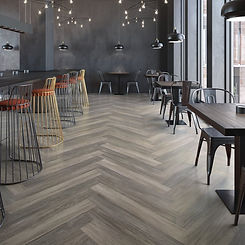
LVT - Luxury Vinyl Tiles
LVT, or luxury vinyl tile, is a type of modular vinyl flooring. Unlike traditional vinyl flooring, in which single sheets are used, tiles are laid out individually. It’s often designed to look like real wood or stone, but has more practical benefits than natural materials.
Vinyl floor tiles have a high quality finish, making them ideal for commercial and corporate environments. Designed to enable creative designs that make an impact – they are visually striking, versatile, and easy to install
Aesthetics
With a huge range of realistic wood and stone designs to choose from, it’s easy to recreate the natural look of a wood or stone floor but with all the benefits of luxury vinyl flooring.
Using different shades of the same design, or a mix of wood and stone designs, LVT can be used to create zoning to facilitate wayfinding.
To create a personalised design or to identify areas that have different functions, designs can incorporate borders or ‘rug’ type features and use a combination of contrasting colours and textures.
In environments such as retirement or care homes that require a ‘home-from-home’ feel, specifying LVT in an authentic wood or stone effect can meet requirements for a domestic look yet also meet a project’s technical specifications. Making use of familiar looking wood flooring designs ensures care environments can also be soothing and comfortable.
Particularly important for areas designed to be dementia-friendly or suitable for the visually impaired, combinations of different colourways and light reflective values (LRV) can help people identify locations and direction, giving a sense of independence and security.
Emboss
There are two common emboss types used in LVT products; a random texture (or emboss) and a registered emboss. The first provides an emboss that varies in texture, from a light emboss that barely effects the aesthetics of the product to a stronger texture that changes the look of the LVT from a smooth engineered finish to a more rustic appearance or even an effect that mimics a hand finished texture found in some wood products, such as hand scraped wood.
A registered emboss delivers a texture that is registered to, or matches, the image used in the print layer. For instance, a knot in a plank can be seen but the inherent roughness or texture can also be felt, and they match. Registered emboss products are available in woods, stone, pebbles and contemporary blend LVT products.
Wearlayer
The thicker the wearlayer, the more durable the product. The international standards ISO 10582 and ISO 10874 help specifiers relate wear layer thickness of a product to its end-use suitability. For example, most commercial applications state that a 0.55mm wearlayer is required. This will provide good wear characteristics for heavy commercial applications. For very heavy commercial traffic areas, 0.7mm is preferable as this will provide a thicker wearlayer and therefore longer lasting floorcovering.
Bevel
Where a product has a thicker wearlayer, it’s possible to supply the product with a bevelled edge. When the product is laid, these bevels bring a third dimension to the floor and add additional authenticity to the surface
.
Hygiene
LVT is waterproof, resisting spills and avoiding dust and mites, contributing to a cleaner, healthier environment. Specifiers are advised to look out for floors benefiting from a surface protection system using PU technology. This will provide a hygienic and durable finish that will protect the floor for years to come.
With LVT products produced with a low volatile organic compound rating and using adhesives free from harmful emissions, specifying this flooring can help meet project requirements for anti-allergen environments.
Slip resistance
It’s important to recognise the slip resistance of an installed floor can be affected by surface contamination such as water and grease from spillages, inappropriate maintenance techniques and wear. So, consideration must be given to whether the floor in use will be always dry or if contamination is likely and whether it will be subjected to heavy traffic, as these factors can influence installed slip resistance and safety.
The Pendulum Method (BS 7976) is used to assess the slip resistance of LVT in the UK and it’s the preferred method of the Health and Safety Executive. Testing the wet and dry rating, the Pendulum method was first introduced by the UK Slip Resistance Group.
Recognising the importance of slip resistance in health, care and education environments, Karndean has worked with its supply chain to develop a range of wood and stone designs, Opus Enhance, which boasts a result of 40-plus in the Pendulum Wet Test.
Versatile geometric designs
Although LVT has always offered endless design capabilities using wood and stone effect planks and tiles, solid colours and geometric shapes have been introduced to offer new opportunities to recreate create period features such as classical tiled floors or to design a unique statement floor.
With geometric shapes, such as triangles, chevrons and hexagons, cut in wood or stone designs, it’s possible to create a unique statement floor for any situation. A 3D effect can be created with repeating patterns in three colours to give an individual style and visual interest to commercial and residential spaces.
Alternatively, the opulence of historic interiors can be recreated with heritage patterns of tiles in solid colours. With such wide scope for shape and colour, the only limit to an LVT floor is the designer’s imagination.
Unlike other materials, LVT can be intricately cut to create any bespoke shape or image, logo and mission statement, which can be matched to fit in with the overall floor design.
*credit - Paul Barratt - Karndean





